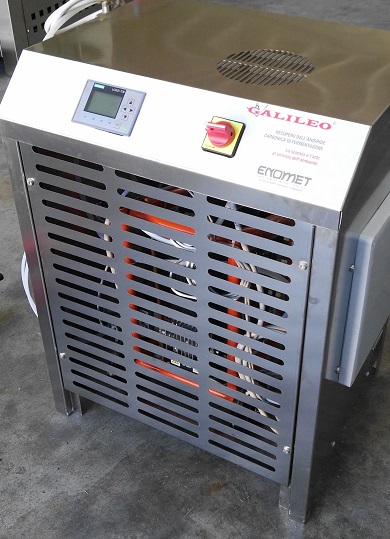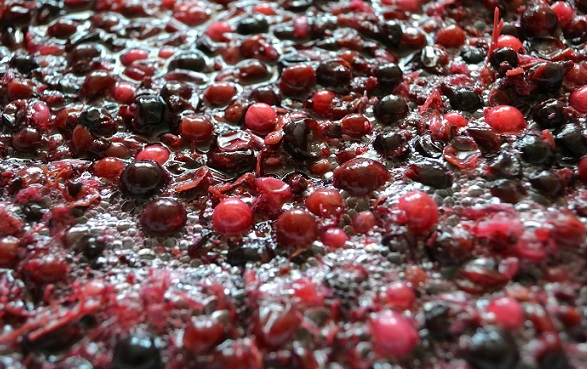The difference is one of timing and scale. Wineries mainly discharge CO2 for a few months of the year during vintage, power plants continually. Power plants also release much more CO2 than wineries.
Wineries release CO2 into the atmosphere during the fermentation process, where one molecule of sugar yields two molecules of ethanol and two molecules of CO2.
We are all familiar with images of white smoke billowing out of power plant chimneys, but not out of wineries. How come? This is because carbon dioxide is invisible, and it is steam that is seen emerging from power station chimneys. So, wineries and brewers escape environmentalists’ attention. But for how long?
Fermentation CO2 emissions: Should they continue?
CO2 emissions from fermentation are a small proportion of the carbon produced in wine production, but is this an excuse for the continuation of such environmental vandalism? Moreover, many wineries purchase compressed CO2 for use in sparging tanks of oxygen, yet another source of emission to the atmosphere!
What is the alternative? To capture fermentation CO2 – it is 90% pure – then clean it of impurities, compress it and either reuse or sell it. Such systems are commercially available now, for example from Enomet (above) from Italy and Oresteo in Spain. Such systems are more common in breweries, and are even available for microbreweries (Earthly Labs, USA).
Château Smith Haut Lafitte of Bordeaux is using a process developed by the French firm Alcion Environnement to capture fermentation CO2 as bicarbonate of soda (sodium bicarbonate). The Wine Council of Bordeaux, the CIVB (Conseil Interprofessionnel du Vin de Bordeaux), is showcasing the initiative as a good example of how to lower CO2 emissions from fermentation.
'In today’s environmentally-aware society, it is important that the sector improves its performance and reduces its carbon footprint'
The wine industry as a carbon polluter
It is common now for various industries to calculate their carbon footprint, using agreed protocols which typically count all inputs in a “cradle to grave” analysis. This has been done for the grape and wine sectors in several countries. I refer here to one produced at the Australian Wine Research Institute by Abbott et al (2016), with a subsequent summary by Abbot and Wilkes (2019), which covers winery emissions of fermentation CO2 in some detail.Compared to other Australian industries, wine is a small contributor to greenhouse gas emission. Wine was estimated to have a carbon footprint of 1.6 million tonnes of CO2 equivalent, compared to 22 million tonnes for civil aviation and 101 million tonnes for transport in general. The wine figure is averaged over packaging (glass or bulk) and the production mix (local vs export, glass vs bulk, and large vs small wineries).
Winemaking itself contributes 17% of the footprint, and grapegrowing 15% – together only 32% of the total. Glass production, transport and bottling of bulk wine in its final destination make up the bulk of the footprint. We conclude that the grape and wine sector is a small contributor to atmospheric CO2 pollution.
However, in today’s environmentally-aware society, it is important that the sector improves its performance and reduces its carbon footprint. This is an age where people are talking about a “climate emergency”, when individuals, families, large communities and small alike are encouraged to take direct action – a challenge also emphasised for manufacturing industries such as grapes and wine.
'Pomace, stalks and prunings can be used for energy'
How can the grape and wine sector minimise carbon pollution?
The answer lies in carbon footprint analyses – which factors are the major contributors to CO2 emission? The standard 750ml glass bottle is the main villain, being weighty, volume demanding and energetically expensive to transport, manufacture and recycle. A wander around supermarkets shows there are many other packaging alternatives for liquids. Lower value wines are infrequently cellared nowadays, being generally purchased for immediate consumption, and so expensive containers like glass bottles, designed for storage, seem unnecessary, as well as environmentally undesirable.The grape and wine sectors can take heart that some modern research, machinery and process developments are available to minimise carbon footprints. For vineyards, these could involve use of biofuels, improved irrigation efficiency and electricity savings, and reductions in agricultural chemical use. Vineyards can also contribute pruning debris as biomass for winery or civic use for heat or electricity generation.
Electricity production remains largely dependent on fossil fuels, and winery demands for heating/cooling and lighting are major contributors to the carbon footprint. Biomass combustion in special boilers can generate electricity and heat, and European studies suggest that pomace, stalks and prunings as renewable energy sources can contribute significantly as electricity alternatives. This approach and others will be discussed in more detail in future articles for Canopy (sign up here), along with other mitigation strategies for the grape and wine sectors.

Dubious carbon accounting?
The most widely used carbon calculator for wine comes from FIVS, a Paris-based organisation with members in 23 countries and a substantial Californian large winery membership and representation on the executive.Its protocol deliberately excludes CO2 emissions from fermentation. The “justification” for this is to label such emissions as “biogenic”; that is, it does not need to be accounted for since it is balanced by the annual growth cycle of the vine in capturing CO2 by photosynthesis, the so-called “short term” carbon cycle.
One wonders why there is the mandatory exclusion of fermentation CO2 in the FIVS model. Is it to do with wanting to avoid legislative interest in such emissions? By way of comparison, the OIV (2017) carbon calculator allows for the optional exclusion of fermentation CO2.
'There appears no valid reason why wineries should continue to treat the atmosphere as a sewer for CO2'
Conclusion
There appears no valid reason why wineries should continue to treat the atmosphere as a sewer for CO2. The means are available to avoid this, admittedly at a cost.I conclude with a question:
How long before an environmentally sensitive wine consumer is able to purchase a cardboard package of wine bearing the label “During the fermentation of this wine no carbon dioxide was released into the atmosphere”?
Dr Richard Smart is an experienced viticultural scientist and consultant. He can be contacted using vinedoctor@smartvit.com.au
References
1. Abbott, T., Longbottom, M.,Wilkes, E. and Johnson, D. (2016).Assessing the environmental credentials of Australian wine. Wine Vitic. J. 31 (1):35-37.
2. Abbott, T. and Wilkes, E. (2019) Understanding carbon emissions in the wine industry. Aust. & NZ Grapegrower &Winemaker, April (663):71-72. This paper can be requested via the AWRI website and delivered free of charge via email.













.png)






